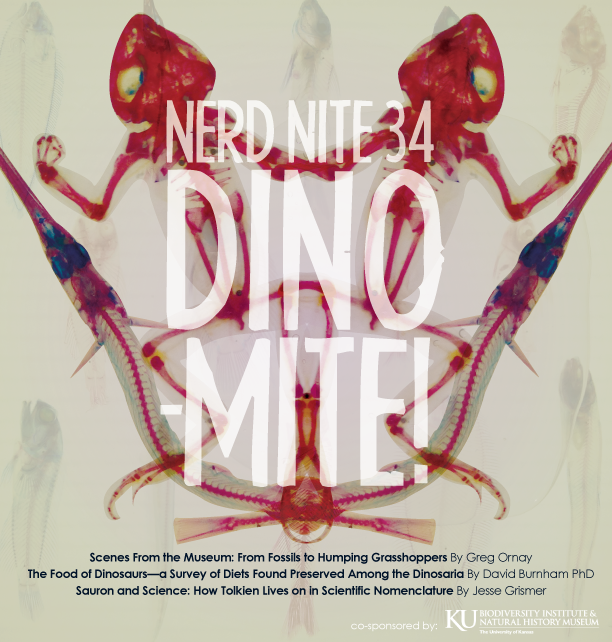We’re Back! And this month Nerd Nite is teaming up with the KU Biodiversity Institute and Natural History museum to bring you three nerdy presentations exploring the museum, dino diets, and the Tolkien inspired naming of new species. We will still be at Pachamama’s Alton Ballroom for the next couple months so you can get your fill of Pachamama’s before they close after Valentine’s Day 🙁
Join us: January 14th. Doors at 7:30, presentations at 8:00 pm! $1 cover. Come early to experience our activity table where you can make your own fossil print!
Presentations include:
Greg Ornay “Scenes from the Museum: From Fossils to Humping Grasshoppers”
Working at KU Natural History Museum you get to see many unique things and get caught up in some crazy situations dealing with live animals (sometimes wild ones) and insects. There are over 10 million specimens and only a small percentage makes it into the public exhibits. Working as an exhibits specialist has allowed my to go behind the scenes and explore some of the most extensive and unique collections. I will take you on a journey behind the scenes of Bug Town, the bee colony, secrets of the panorama, creating exhibits that connect and resonate with people, and much more that have been in the making for years and still continuing.
Greg first started out, as an artist working is such mediums as Sculpture, performance and installation art. During his time in College he worked for several art galleries and a few museums. Always being on the creative side he wound up working for KU’s Natural History Museum. For the last 10 years he has been creating exhibits at the museum. From concept, design, fabrication, and installation he has used his art background to showcase new exhibits to the public.
Jesse Grismer “Sauron and Science: How Tolkien Lives on in Scientific Nomenclature”
Naming new species of plants and animals can be a great way to bridge passions eg. fantasy, comics, scifi, research, etc. When a new species is discovered we get to choose the species’ name. So we have named species after Gollum or from areas in the Tolkien Universe such as the Elves of Las Gallen. There is no reason not to infuse research with other areas of our lives that we are passionate and excited about. This also how shows that not all scientist are stuffy or dorky and makes our work more engaging to the general public. It gets them asking questions, like can you do that? Does it still count? Then this opens up a dialogue about how and why describing species is important and vital to conservation but can also be a blast man!!
David Burnham “The Food of Dinosaurs—a survey of diets found preserved among the Dinosauria”
My talk is about dinosaurs and what they ate. Not what we think they ate based on their teeth and claws, but rather on scientific evidence such as what was found inside their bellies. Such remains of the past are rare insights and bring interesting conclusions that I will share during my talk.
David read the stories that are embedded in the rocks. Rocks are time capsules and if you learn how to read them they become windows into the past. This allows one to time travel and see long extinct life forms from a very distant past. And that is what captivates David to this day. Soon he realized that looking was no longer enough. Not only did he want to look into the past, David also want to extract the primitive life forms that seemed to be locked in stone. You see, the name fossil means something “dug up” and he wanted to do just that. However, he wanted to not only go back in time, but he wanted to put fossil organisms back together and make them whole again. Then he would see the entire picture and discover the unknown. This has manifested itself as a life-long career as a time traveler. In more formal circles we are called Paleontologists. But we remain as inquisitive children looking at rocks and stones for clues no one else can see.
